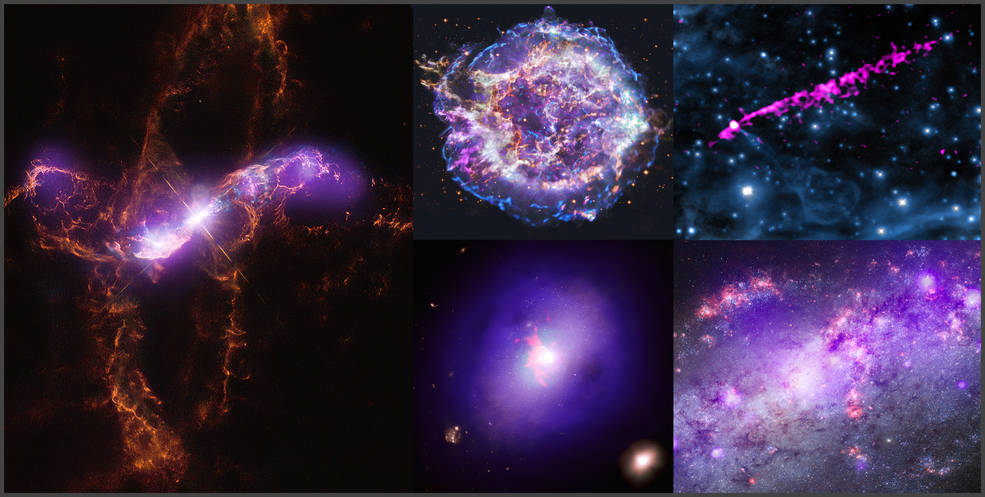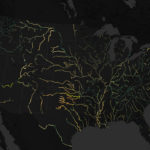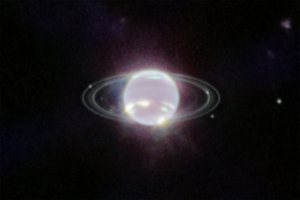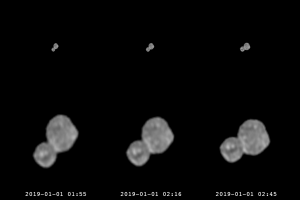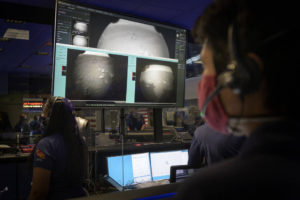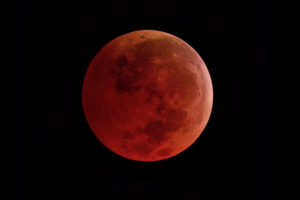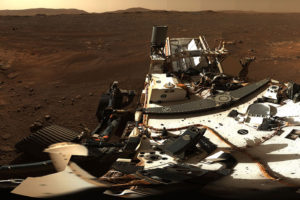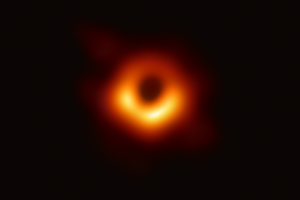Credits: X-ray: NASA/CXC/SAO; Optical: NASA/STScI, Palomar Observatory, DSS; Radio: NSF/NRAO/VLA; H-Alpha: LCO/IMACS/MMTF
NASAがチャンドラX線観測衛星で撮影したX線データと、他の天体望遠鏡のX線データを組み合わせた新しい画像を公開しました。
みずがめ座、カシオペア座、ギター星雲、エイベル銀河団、NGC4490の美しい5枚の画像です。
NASAの公式サイトのURLはこちら:
以下は記事全文と和訳です。
An Expanse of Light
The recent launches of the James Webb Space Telescope (Webb) and the Imaging X-ray Polarimetry Explorer (IXPE) by NASA and its international partners are excellent reminders that the universe emits light or energy in many different forms. To fully investigate cosmic objects and phenomena, scientists need telescopes that can detect light across what is known as the electromagnetic spectrum.
最近打ち上げられた ジェームズウェブ宇宙望遠鏡(Webb)と、NASAと国際的なパートナーによるX線観測衛星(IXPE)は、宇宙がさまざまな形で光やエネルギーを放出していることを確認することができる優れた成果をもたらせてくれます。宇宙の物体や現象を十分に調査するため、科学者は電磁スペクトルとして知られている光を全て検出できる望遠鏡を必要としています。
This gallery provides examples of the ways that different types of light from telescopes on the ground and in space can be combined. The common thread in each of these selections is data from NASA’s Chandra X-ray Observatory, illustrating how X-rays — which are emitted by very hot and energetic processes — are found throughout the Universe.
この5枚の画像からは、地上と宇宙の望遠鏡によりさまざまな種類の光を組み合わせる方法が示されています。これらに共通しているのはNASAのチャンドラX線観測衛星からのデータであり、非常に高温かつ高エネルギーで放出されるX線が宇宙空間でどのように検出されるかを示しています。
R Aquarii: (みずがめ座)
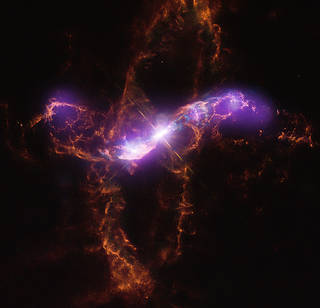
This object is, in fact, a pair: a white dwarf star that steadily burns at a relatively cool temperature and a highly variable red giant. As they orbit each other, the white dwarf pulls material from the red giant onto its surface. Over time, enough of this material accumulates and triggers an explosion. Astronomers have seen such outbursts over recent decades. Evidence for much older outbursts is seen in the spectacular structures observed by NASA’s Hubble Space Telescope (red and blue). X-ray data from Chandra (purple) shows how a jet from the white dwarf is striking material surrounding it and creating shock waves, similar to sonic booms from supersonic planes.
この天体は、実際には2つのペアです。比較的低温で着実に燃える白色矮星と、非常に変化しやすい赤色巨星です。それらが互いに軌道を回る際に、白色矮星は赤色巨星からその表面に物質を引き寄せます。時間の経過とともに、この物質が十分に蓄積され爆発を引き起こします。天文学者はここ数十年にわたってそのような爆発を観察してきました。 NASAのハッブル宇宙望遠鏡(赤と青)によって観測された壮観な構造には、はるかに古い爆発の証拠が見られます。チャンドラX線観測衛星(紫)からのX線データは、白色矮星からのジェットが、超音速機による衝撃波と同様に、周囲の物質に衝突して衝撃波を生成している様子を示しています。
Cassiopeia A: (カシオペアA)
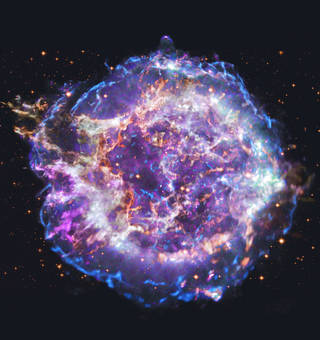
Chandra’s observations of the Cassiopeia A supernova remnant have shown how individual elements from the exploded star are being cast off into space. In this image, X-rays reveal silicon (red), sulfur (yellow), calcium (green), and iron (light purple). The blue around the rim of the remnant reveals the blast wave from the explosion as it travels outward. This image also adds a layer of radio data of Cassiopeia A from the National Science Foundation’s Karl Jansky Very Large Array (dark purple, blue, and white) and an optical image from Hubble (orange). Like X-rays, radio waves can penetrate thick clouds of gas and dust that lie between Earth and Cassiopeia A, providing additional information about this famous stellar explosion.
チャンドラX線観測衛星によるカシオペアAの超新星残骸の観測では、爆発した星からの個々の物質がどのように宇宙に放出されているかを示しています。この画像では、X線により、シリコン(赤)、硫黄(黄色)、カルシウム(緑)、および鉄(薄紫)を識別することができます。残骸の縁の周りの青は、爆発が外に向かって進む際の爆風を示しています。この画像には、国立科学財団のカールヤンスキー超大型アレイ(濃紫、青、白)からのカシオペアAの無線データの層と、ハッブル(オレンジ)からの光学画像も追加されています。 X線のように、電波は地球とカシオペアAの間にあるガスや塵の厚い雲を透過し、この有名な恒星の爆発に関する追加情報を提供してくれるのです。
Guitar Nebula: (ギター星雲)
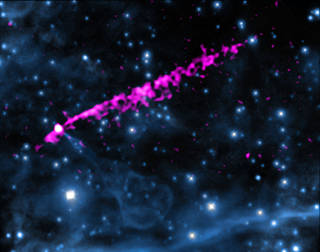
For the last decade or so, astronomers have been puzzled by the alignment of some jets of X-rays coming from very fast-moving pulsars (that is, spinning neutron stars) that shoot out into interstellar space at odd, unexpected angles. This is what astronomers see with PSR B2224+65, a pulsar found near the structure nicknamed the “Guitar Nebula” due to its shape in optical light (blue). An X-ray stream (pink) captured by Chandra is pointed nearly perpendicular to the guitar-shaped structure, originating from the magnetic poles of the pulsar.
過去10年ほどの間、天文学者は、星間空間に奇妙に予期しない角度で放出される非常に高速で移動するパルサー(即ち、回転する中性子星)から来るX線のジェットの列に戸惑っていました。これは、天文学者がPSR B2224 + 65で見るものです。これは、光学光(青)での形状から「ギター星雲」と名付けられたものの近くで見つかったパルサーです。チャンドラX線観測衛星により観測されたX線ストリーム(ピンク)は、パルサーの磁極から発生するギターの形をした構造にほぼ垂直になっています。
Abell 2597: (エイベル2597銀河団)
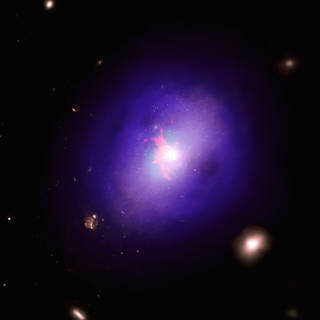
Galaxy clusters, the largest structures in the universe held together by gravity, are dynamic environments containing individual galaxies and huge amounts of hot gas and dark matter. Often, an enormous black hole in the center of a cluster can help drive its behavior. In the galaxy cluster Abell 2597, a giant central supermassive black hole is driving the gas outward and creating bubbles, or voids, within it. This composite image of Abell 2597 includes X-rays from Chandra (blue), optical data from the Digitized Sky Survey (orange), and emission from hydrogen atoms in optical light from the Las Campanas Observatory in Chile (red).
重力によって結合された宇宙最大の構造である銀河団は、個々の銀河と大量の高温ガスと暗黒物質を含むダイナミックなものです。多くの場合、クラスターの中心にある巨大なブラックホールは、クラスターの変化を引き起こす元となっています。エイベル2597銀河団では、中央にある超巨大質量のブラックホールがガスを外側に押し出し、その中に気泡または空洞を作り出しています。このエイベル2597の合成画像には、チャンドラからのX線(青)、デジタル化された全天の写真星図データベース(オレンジ)、チリのラスカンパナス天文台からの光学光中の水素原子からの放出(赤)が含まれています。
NGC 4490:
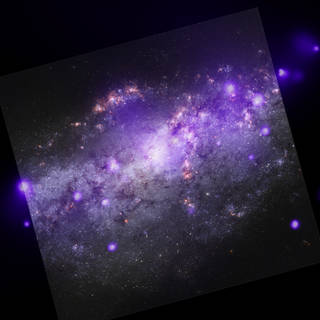
When two galaxies are in the process of merging, the gravitational interaction can trigger waves of star formation. This is the case for NGC 4490, a spiral galaxy that has collided with a smaller galaxy to the upper right but not seen in this image. Scientists think that these two galaxies have already had their closest approach and are now separating from one another. Some of the point-like sources of X-rays represent stellar-mass black holes and neutron stars within the galaxy. In this image of NGC 4490, X-rays from Chandra (purple) have been combined with an optical image from Hubble (red, green, and blue).
2つの銀河が合体する過程にある場合、重力相互作用は星形成の波を引き起こす可能性があります。この画像は右上の小さな銀河と衝突した渦巻銀河であるNGC 4490ですが、この画像では見ることができません。科学者たちは、これら2つの銀河はすでに最接近しており、現在は互いに分離し始めていると考えています。点状のX線源のいくつかは、銀河内の恒星質量ブラックホールと中性子星を表しています。このNGC4490の画像では、チャンドラX線観測衛星(紫)で観測したX線が、ハッブル宇宙望遠鏡からの光学画像(赤、緑、青)と組み合わされています。
NASA’s Marshall Space Flight Center manages the Chandra program. The Smithsonian Astrophysical Observatory’s Chandra X-ray Center controls science operations from Cambridge, Massachusetts, and flight operations from Burlington, Massachusetts.
Read more from NASA’s Chandra X-ray Observatory.
For more Chandra images, multimedia and related materials, visit:
http://www.nasa.gov/chandra
Megan Watzke
Chandra X-ray Center, Cambridge, Mass.
617-496-7998
mwatzke@cfa.harvard.edu
Molly Porter
Marshall Space Flight Center, Huntsville, Ala.
256-544-0034
molly.a.porter@nasa.gov
Last Updated: Feb 3, 2022
Editor: Lee Mohon
